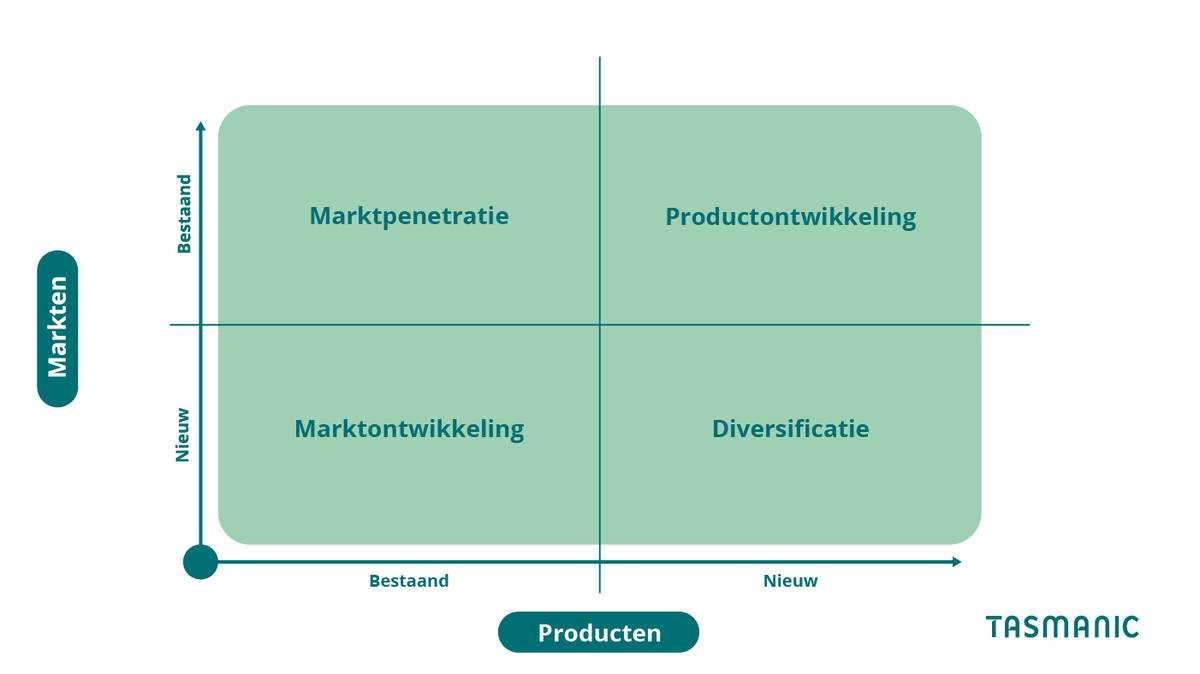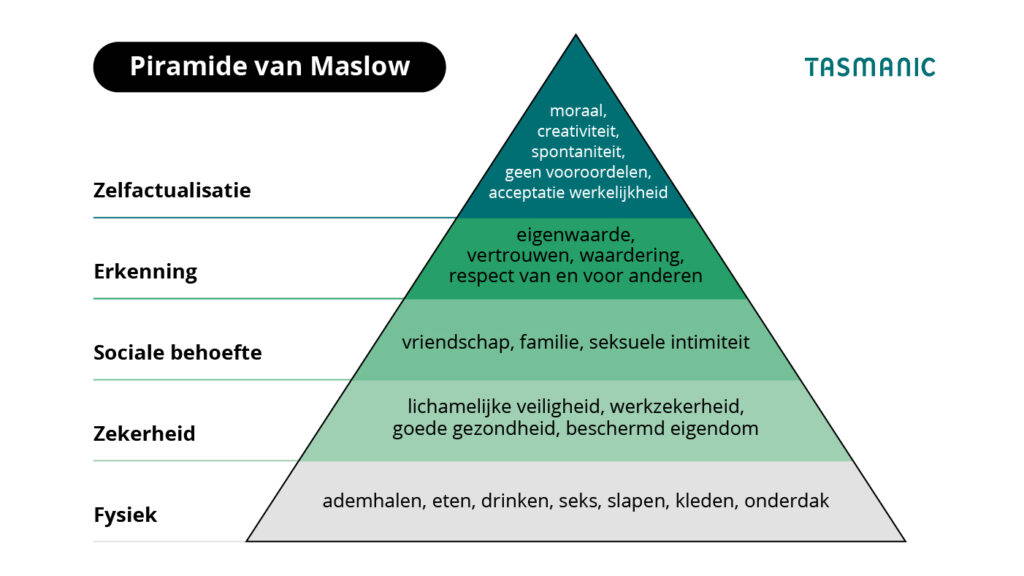
Introduction
Just started your own business, or maybe you've had a business for a while but want to take the next step? In this article, we explain how to grow your business using Ansoff's growth strategy model. We also provide instructive real-world examples.
What is a growth strategy
A growth strategy is a plan used to increase sales, increase profits or achieve other long-term goals of a company. Growth strategies can take different forms and depend on a company's specific goals, resources and market conditions.
Growth strategy: Ansoff model/matrix
A popular growth strategy model is the Ansoff matrix. This model was developed by economist Igor Ansoff and was first published in an article in 1957. Companies can use the Ansoff matrix to determine the company's growth strategy. The Ansoff model consists of four strategies shown below.

This model provides growth strategies by combining new and existing products and markets. Each quadrant represents a growth strategy: market penetration, product development, market development and diversification.
Market penetration
The market penetration strategy of the Ansoff matrix focuses on increasing market share in existing markets by selling existing products or services to customers. The goal is to attract more customers (market broadening) or to generate more sales through existing customers (market deepening). This can be achieved, for example, by lowering prices, running promotions or improving the quality of products. Opening new distribution channels and improving customer loyalty are also market penetration tactics.
The goal is to outperform the competition in the existing market to gain a higher market share, and more sales. Market penetration is the lowest-risk growth strategy.
-
Example market penetration: Nike
An example of a company with a market penetration strategy is Nike. Nike has been one of the largest sportswear and footwear brands in the world for many years and has a huge customer base. To increase market penetration, Nike has implemented various strategies such as marketing campaigns, sponsorship of sporting events and athletes to retain customers and gain new ones. Nike also often offers discounts and promotions to entice customers to buy more products. All these strategies help Nike increase their market share and maintain and strengthen their position as a leader in the sports industry.
Product development
The product development strategy of the Ansoff model focuses on developing new products for existing markets. By doing so, you want to increase market share and strengthen your company's competitive position. This strategy involves research to develop new products that are also attractive to existing markets. This research should analyze which products best fit the customers' needs. These new products will have to be better than those of the competition, with which you can increase customer satisfaction and loyalty.
This strategy has medium risk because a company focuses on familiar markets but with new products.
-
Example product development: LEGO
An example of a company that adopted the product development strategy is LEGO. The company began as a manufacturer of wooden toys and later evolved into a manufacturer of plastic building blocks. In recent decades, LEGO has expanded its product line with new toy lines, including LEGO Technic, LEGO Mindstorms and LEGO Friends.
Market Development
The next growth strategy is market development, where a company tries to find new markets for their existing products or services. By this we mean that a company wants to expand its customer base by entering new geographic areas or demographic segments that it has not reached before. In market development, the company may focus on existing products and adapt them to the needs of a new market. Alternatively, the company may explore new channels or distribution channels to expand the reach of the product. For example, selling products through a new online platform or partnering with another company to sell the products in new regions.
Market development as a strategy also brings risks, such as the lack of knowledge of new markets, competition from local players and high marketing and distribution costs to reach new markets.
-
Market development example: Coca Cola
An example of a company with a market development strategy is Coca-Cola. In the 1990s, Coca-Cola had a strong presence in the U.S. market, but the soft drink producer was struggling to expand internationally. For this reason, Coca-Cola decided to apply the market development strategy and focus on increasing their presence in new international markets. They adapted their marketing strategy to account for cultural differences and introduced new flavors and products to better suit local preferences. For example, the taste of Fanta varies by country.
-
Market development example: LEGO
- Another example of market development is again LEGO. For years, LEGO only released LEGO sets for children, although LEGO was also popular with adults. For several years now, the Danish toy manufacturer has been releasing sets specifically for adults. With this it manages to successfully reach a new demographic target group.
Diversification
The final growth strategy of the Ansoff model is diversification, in which a company will develop new products and offer them in new markets. These can be products related to your existing offerings or completely new products.
With diversification, companies seek to spread risk and create new sources of revenue. By entering new markets and offering new products, the company can reduce its dependence on a particular market or product. However, it can also come with higher costs for research and development and building new knowledge and skills. In addition, it may be difficult to find the right product-market combinations, and competition in new markets may be fiercer. Diversification is the highest-risk growth strategy.
-
Example diversification: Apple
An example of a company that has adopted diversification as a strategy is Apple. Apple has launched several new products over the years, such as the iPod, iPhone, iPad and Apple Watch. As a result, the company has expanded its product line and tapped into new markets. By continuing to innovate and develop new products, Apple has managed to capture a large market share and build a loyal customer base.
Choosing the right growth strategy for your business
When making the choice to grow as a business, it is important to determine which strategy best fits your company's business goals and strengths. If all goes well, in your business plan you already have a clear understanding of the markets you operate in, and the products and/or services you offer. According to the Ansoff matrix, you need to make two choices if you want to grow as a business.
- Enter new market or increase your sales in the current market:
In doing so, think carefully about whether there is still room for growth in the existing markets you are in and what are the implications if I enter a new market. Is there demand for my product in other markets? For example, you can investigate whether there is demand abroad for your products or services.
- Develop new product or with current product (possibly minor modification):
Here it is important to look at your current product demand and market opportunities. Can you easily increase sales with your current product, or do you see opportunities in customer needs with developing a new product.
If you can answer these two questions, you can select your growth strategy from the Ansoff matrix. For example, if your research shows that you can increase your profits with your current product in a new market, choose the market development strategy.
If you are about to launch a new product or service, also read our article on creating a go-to-market strategy.
Are the results from your online marketing disappointing?
Request our no-obligation performance scan and we'll tell you where you're going wrong.

















 Team
Team FAQ
FAQ Vacancies
Vacancies Contac
Contac AWR
AWR Ahrefs
Ahrefs Channable
Channable ContentKing
ContentKing Leadinfo
Leadinfo Optmyzr
Optmyzr Qooqie
Qooqie Hubspo
Hubspo Semrush
Semrush




